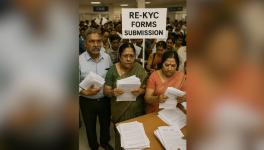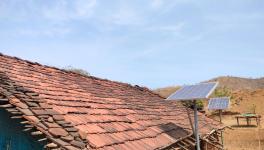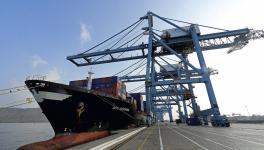Safeguard Duty on Imported Solar Energy Equipment a Flop Show?
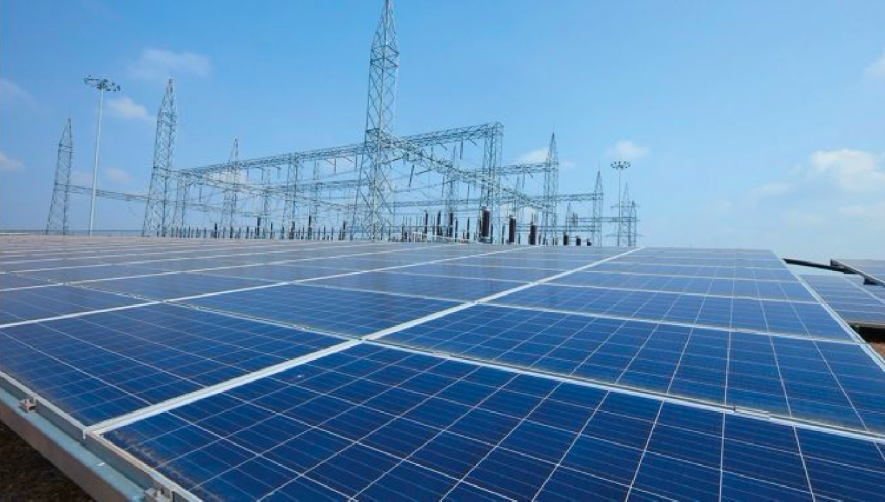
Prime Minister Narendra Modi has stated that India aspires to generate 100 gigawatt (GW) of solar energy by 2022. He wants the country to become a “hub” for the manufacture of solar power batteries. Given the recent flip-flops in the government’s tax policies, this goal is unlikely to be easily achieved.
An analysis by the Council on Energy, Environment and Water (CEEW), a New Delhi-based think-tank, has concluded that the decision of the Ministry of Finance to impose a safeguard duty on imports of solar cells and modules from China and Malaysia on July 30, 2018, has failed to achieve its objective of providing a push to domestic firms manufacturing equipment for generating solar energy.
A CEEW analysis, published on August 29, points out that while the imposition of the safeguard duty succeeded in reducing imports of solar cells and modules by 23% between August 2018 and July 2019, there was a parallel decline in deployment of solar power projects in this period. Consequently, the safeguard duty regime had “little to no effect” on the market shares of domestic companies.
An earlier report published in June by CEEW titled “What is the safeguard duty safeguarding?” by Arjun Dutt, Manu Aggarwal and Kanika Chawla, stated that out of all the domestic manufacturers and fabricators of solar power equipment – including modules and battery cells – those engaged in the production of modules would bear the brunt of the industry’s losses. The total capacity for manufacturing solar cells in India is currently 3.1 GW while that of modules is 8.9 GW.
Of late, module manufacturers located both within the Domestic Tariff Area (DTA) as well as in Special Economic Zones (SEZs) – where they are exempt from payment of customs duty as the bulk of the output is expected to be exported – have been incurring losses.
The competitive potential of manufacturers in SEZs has been eroded because they are subject to safeguard duties that are similar to those imposed on foreign manufacturers under Section 30 of the SEZ Act of 2005. Since many manufacturers of solar modules rely heavily on imported cells, the input costs of such companies in the DTA have gone up significantly.
The CEEW report notes: “Not all Indian PV (photo-voltaic) manufacturers of (of both solar cells and modules) benefit from the imposition of safeguard duties. While cell manufacturers located within the DTA and in SEZs would benefit from improved competitiveness resulting from the imposition of duties on competing imported cells, the same is not true for module manufacturers.”
CEEW also points out that based on data available with the Ministry of Commerce and Industry, while the safeguard duty has resulted in the share in solar equipment imports from China and Malaysia falling, the share of imports from countries like Singapore, Thailand and Vietnam (that have been exempt from safeguard duty) increased substantially.
Between August 2018 and July 2019, the share of Singapore in total imports of solar cells increased sharply from 1.1% to 5.6%, while that of Thailand rose from 0.1% to 5.0% and Vietnam’s share went up from 0.4% to 6.3%. See Table 1 below.
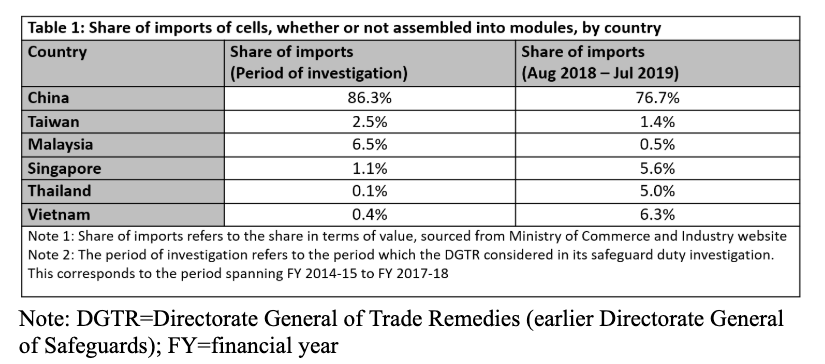
As mentioned, the Ministry of Finance had notified a two-year safeguard duty regime on imports of solar cells and modules from China and Malaysia in July 2018 in an apparent push to protect domestic companies in the solar market. The safeguard duty on imports was set at 25% for the first year and 20% and 15% for the subsequent six months, respectively.
Due to the slowing down of project deployment, this resulted in loss of employment opportunities, the CEEW report added.
Experts had told NewsClick in 2018 that only 10% of the jobs in this sector are created during the process of manufacturing of cells and modules. The bulk of the employment generation takes place when projects are set up and projects are electricity generated.
The safeguard duty had increased the price of equipment, which, in turn, has resulted in project costs as well as electricity tariffs going up. Tariff rates had dropped to a record low of Rs 2.44 per unit (or kilowatt hour) in May 2017 but rose after the safeguard duty was imposed.
According to another CEEW report, “... the increase in tariffs discovered led to the cancellation of nearly 5 gigawatts (GW) of awarded project capacity by various tendering agencies in 2018.”
This was clearly a blow to the government’s goal of installing 100 GW of solar power capacity by 2022.
According to data of the Ministry of New and Renewable Energy, only 24.33 GW of solar power capacity had been installed as of October 31, 2018. During the five-year period from FY2014 to FY2018, 20 GW of solar power capacity had been added in the country.
In August 2018, ratings agency Crisil had released a report which claimed that the maximum solar power capacity India could hope to reach by 2022 would be 78-80 GW, or around a fifth lower than the government’s target.
According to the clean energy research organisation, Mercom, there was a dip of 15.5% in installing PV capacity in the calendar year 2018 as only 8.2 GW of solar capacity had been added. In the previous calendar year 2017, the addition to capacity had been 9.7 GW.
Mercom noted that the imposition of the safeguard duty together with difficulties relating to the levy of the goods and service tax (GST), acquisition of land and transmission of electricity, were responsible for the deceleration in adding capacity.
According to the Mercom report of May 7, 2019, India’s solar power capacity as on March 2019, had reached 30 GW. This figure is less than a third of the government’s target for 2022.
The CEEW report too points out that Indian solar cells and module manufacturers do not yet have the capacity to achieve the ambitious aims of the Indian government. To fulfil the target of setting up 100 GW by 2022, the country would have to add more than 20 GW of installed solar capacity each year. However, as stated, India’s annual installed capacities for manufacture of cells and modules are just 3.1 GW and 8.9 GW, respectively.
Tim Buckley, the Australia-based director of energy finance studies, with the Institute for Energy Economics and Financial Analysis, told Caravan magazine: “The solar-module import duty is an own goal for India at a time when India’s solar mission had put it in the centre of the world stage as a world leader.”
According to CEEW, there are certain disadvantages in manufacturing PV equipment in India, which were not addressed when the government decided to impose the safeguard duty. These include higher electricity prices, lack of vertical integration, inferior terms for obtaining debt capital, low scale of operations, lack of demand visibility and outdated technology.
In isolation, the safeguard duty could never have helped, and did not.
Despite the fact that the safeguard duty did not result in the market shares of domestic manufacturers improving, the Ministry of Commerce and Industry collected Rs 3,500 crore between August 2018 and July 2019 as safeguard duty. This money has not yet been earmarked for any specific use for the solar energy sector.
The CEEW report has recommended that the funds be used for ensuring low tariffs in solar PV auctions, “pass-through” of safeguard duties for eligible projects and to support domestic manufacturing.
The Adani Hand: Why Was Safeguard Duty Imposed at All?
The notification imposing the safeguard duty became the “remedy” to an application filed by the Indian Solar Manufacturers Association (ISMA), a representative of 23 solar equipment manufacturers, before the now defunct Directorate General of Safeguards in the Ministry of Finance on December 5, 2017.
It was filed on behalf of Mundra Solar, Websol Energy Systems, Helios Photovoltaic, Indosolar Limited and Jupiter Solar Power. Mundra Solar is part of the Adani group of companies headed by Gautam Adani who is perceived to be close to Prime Minister Narendra Modi.
What is interesting is that three of the companies, Mundra Solar, Helios and Websol, are all located in SEZs and would have had to pay the safeguard duty.
Under Section 30 of the SEZ Act of 2005, units selling their products in the DTA have to pay safeguard duty.
Yet these three companies operating in the SEZs lobbied the government arguing that they should be exempt from paying the duty since they qualified as “domestic” industrial units. For a while, it appeared as if their efforts would be successful.
Did they think the rules would be changed for them? Or was it a grave miscalculation?
Sandeep M Bhatnagar, the then director, DGS, conducted an investigation into allegations of “dumping” of solar equipment after complaints were made by ISMA. His preliminary findings were released on January 5, 2018. He recommended the imposition of a huge import duty of 70% on solar cells imported from two countries, Malaysia and China.
He agreed with the lobby led by the Adani group company and argued that units operating within the SEZs could be treated as “domestic industries” because they were “physically very much in India.” His findings added that the units in SEZs adhere to domestic laws (though with certain relaxations), generate employment, make domestic sales, and so on.
However, Bhatnagar did point out that this interpretation of the law of the land was not within his jurisdiction since it dealt with the SEZ Act. A final decision would have to be taken by the government on this contentious issue. The recommendations in the preliminary findings by Bhatnagar did not, however, result in a policy change by the Indian government.
In May 2018, the DGS was merged with the erstwhile Directorate General of Anti-Dumping and Allied Duties and renamed the Directorate General of Trade Remedies (DGTR) and brought within the administrative ambit of the Ministry of Commerce and Industry.
A fresh investigation conducted by the newly formed DGTR took place based on the petition by ISMA. It released its report in July 2018.
The findings of this report were different from the earlier report by the DGS on two important grounds. It wanted the safeguard duty to be much lower than 70% and recommended that it be reduced in phases. In the first year, there was to be a duty of 25%, followed by 20% in the next six months and 15% in the remaining period of another six months.
Notably, the DGTR did not agree on granting “domestic industry” status to the companies operating out of the SEZs. He argued that selling products by a unit located in a SEZ in the DTA was an “exception” and could not be a justifiable reason for a firm in a SEZ to be described as a “domestic” one.
Even though the SEZ firms led by Mundra Solar lobbied to be exempted from the safeguard duty, their concerns were overlooked when the Ministry of Finance ratified the DGTR’s recommendations on July 30.
The Ministry issued the notification despite a stay order being put on the implementation of the safeguard duty by the Odisha High Court until August 20, 2018.
A bench of the Odisha High Court then directed the Ministry of Finance to withdraw the notification which ratified the DGTR’s recommendations. The finance ministry then suspended the safeguard duty imposed on solar imports. The Supreme Court finally vacated the stay by the Odisha High Court in September 2018.
Thus, despite his apparent proximity to the Prime Minister, Adani’s company was unsuccessful in influencing the Ministry of Finance.
The writers are independent journalists.
Get the latest reports & analysis with people's perspective on Protests, movements & deep analytical videos, discussions of the current affairs in your Telegram app. Subscribe to NewsClick's Telegram channel & get Real-Time updates on stories, as they get published on our website.









